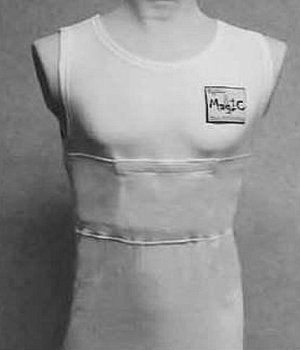Not like cats that you might pet in your lap at night, International Space Station CATS study the atmosphere’s plight. CATS and new research including flatworms, wearable technology, an external radiation monitor and tools to use the station as a microbial observatory will head to the orbiting outpost on the fifth SpaceX mission. Additionally, SpaceX’s Dragon spacecraft will deliver equipment for human research, physical science and educational activities to the station.
 The Magic-Space vest technology embeds wires and sensors into the fabric to monitor astronaut heart rates and breathing patterns during sleep. Image Credit: Italian Space Agency (ASI)
The Magic-Space vest technology embeds wires and sensors into the fabric to monitor astronaut heart rates and breathing patterns during sleep. Image Credit: Italian Space Agency (ASI)
Though CATS does not meow, the Cloud-Aerosol Transport System is a remote-sensing instrument that measures the location, composition and distribution of aerosols – particles that makeup haze, dust, smoke and air pollutants – in the atmosphere. Aerosols can affect weather, climate, airplane safety and human health. CATS measures aerosols using a light detection and ranging (LIDAR) system externally mounted on the station.
With data from CATS, scientists may gain an improved understanding of the structure and evolution of Earth's atmosphere. This could lead to enhancements to spacecraft launch, landing and communications systems. It also may help guide future atmospheric investigations of other planets and help researchers model and predict climate changes on Earth.
Switching from Earth observation studies to biology and biotechnology flying on SpaceX, the Microbial Observatory-1 study examines surface and air samples on the space station to observe which bacteria are present. After a year of collection, the samples will return to Earth for analysis and identification. The investigation helps researchers detect the variety of microbes that survive on the space station and how they change over time.
Scientists gain insight into possible risks to crew health in a confined space through data from Microbial Observatory-1. They can compare data to learn how microbes in space adapt differently than those on Earth. The data from Microbial Observary-1 may provide hints about unknown chemical reactions that occur at the cellular level. This information could be used for antibiotics and antimicrobial agent development.
The Microbial Observatory-1 study also helps scientists develop strategies for the use of –omics technology to screen and identify bacteria in clinical settings. The term –omics refers to a broad area of biological and molecular studies that examine the entire complement of biomolecules, including proteins and genes.
Another biological study, Flatworm Regeneration, investigates the regenerative processes of these animals for detection and repair of complex organ structures. Flatworms redevelop their cells if damaged and as they age. Observation of these processes in orbit may help engineers develop technology that can reconfigure its own components and energy use in deep space. Scientists also gain knowledge into gravity’s effect on tissue regeneration and how wounds heal in space. This insight could influence the development of medicine on Earth with new methods for repairing or restoring damaged tissue from injury or physical impairment.
One of the human health studies aboard Dragon involves wearable technology. Researchers will validate a vest that monitors astronauts’ heart rates and breathing patterns during the Wearable Monitoring investigation. The vest has built-in wires and sensors that work without disturbing the crew members as they sleep. This study helps determine how changes in heart activity relate to astronaut sleep quality. This may help scientists provide strategies to improve crew sleep patterns in space. The wearable technology could simplify sleep pattern monitoring in patients on Earth, as well.
In contrast to the crew’s vest for sleep monitoring, the space station will “wear” a specialized dosimeter – a device that measures radiation – on an external area of the Japanese Experiment Module. The Free-Space Passive Dosimeter for Life-Science Experiment in Space investigation will gather information about space radiation to help manage doses and provide protection to crew members. Researchers may use the data to design new radiation monitoring equipment for astronauts and people who work in medical or industrial areas with potential radiation exposure. This knowledge also may improve design for spacecraft structures that shield internal occupants from radiation.
SpaceX resupply missions such as this one delivering CATS keep orbiting laboratory facilities purring with new technology demonstrations and research. The curiosity of CATS and other researchers may one day achieve breakthroughs not possible on Earth.
Laura Niles
International Space Station Program Science Office and Public Affairs Office
NASA’s Johnson Space Center